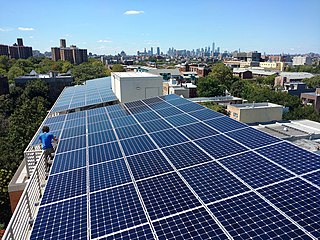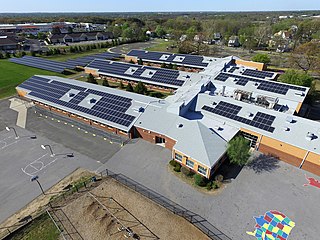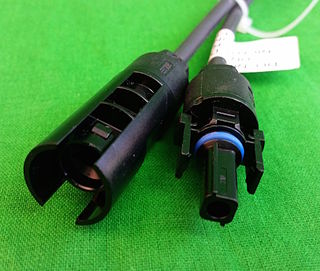Related Research Articles

A solar inverter or photovoltaic (PV) inverter is a type of power inverter which converts the variable direct current (DC) output of a photovoltaic solar panel into a utility frequency alternating current (AC) that can be fed into a commercial electrical grid or used by a local, off-grid electrical network. It is a critical balance of system (BOS)–component in a photovoltaic system, allowing the use of ordinary AC-powered equipment. Solar power inverters have special functions adapted for use with photovoltaic arrays, including maximum power point tracking and anti-islanding protection.

A solar panel is a device that converts sunlight into electricity by using photovoltaic (PV) cells. PV cells are made of materials that produce excited electrons when exposed to light. The electrons flow through a circuit and produce direct current (DC) electricity, which can be used to power various devices or be stored in batteries. Solar panels are also known as solar cell panels, solar electric panels, or PV modules.

Many countries and territories have installed significant solar power capacity into their electrical grids to supplement or provide an alternative to conventional energy sources. Solar power plants use one of two technologies:

Solar shingles, also called photovoltaic shingles, are solar panels designed to look like and function as conventional roofing materials, such as asphalt shingle or slate, while also producing electricity. Solar shingles are a type of solar energy solution known as building-integrated photovoltaics (BIPV).

Solar power is a major contributor to electricity supply in Australia. As of December 2023, Australia's over 3.69 million solar PV installations had a combined capacity of 34.2 GW photovoltaic (PV) solar power. In 2019, 59 solar PV projects with a combined capacity of 2,881 MW were either under construction, constructed or due to start construction having reached financial closure. Solar accounted for 12.4% of Australia's total electrical energy production in 2021.

Solar power has a small but growing role in electricity production in the United Kingdom.

Solar power includes solar farms as well as local distributed generation, mostly on rooftops and increasingly from community solar arrays. In 2023, utility-scale solar power generated 164.5 terawatt-hours (TWh), or 3.9% of electricity in the United States. Total solar generation that year, including estimated small-scale photovoltaic generation, was 238 TWh.
A photovoltaic system, also called a PV system or solar power system, is an electric power system designed to supply usable solar power by means of photovoltaics. It consists of an arrangement of several components, including solar panels to absorb and convert sunlight into electricity, a solar inverter to convert the output from direct to alternating current, as well as mounting, cabling, and other electrical accessories to set up a working system. Many utility-scale PV systems use tracking systems that follow the sun's daily path across the sky to generate more electricity than fixed-mounted systems.

A solar charger is a charger that employs solar energy to supply electricity to devices or batteries. They are generally portable.

SolarCity Corporation was a publicly traded company headquartered in Fremont, California, that sold and installed solar energy generation systems as well as other related products and services to residential, commercial, and industrial customers. The company was founded on July 4, 2006, by Peter and Lyndon Rive, the cousins of SpaceX and Tesla CEO Elon Musk. Tesla acquired SolarCity in 2016, at a cost of approximately US$2.6 billion and reorganized its solar business into Tesla Energy.

New Jersey has over 4,700 MW of installed solar power capacity as of January 2024, which provides more than 7% of the state's electricity consumption. The's state's growth of solar power is aided by a renewable portfolio standard that requires that 22.5% of New Jersey's electricity come from renewable resources by 2021 and 50% by 2030, by incentives provided for generation of solar power, and by one of the most favorable net metering standards in the country, allowing customers of any size array to use net metering, although generation may not exceed annual demand. As of 2018, New Jersey has the sixth-largest installed solar capacity of all U.S. states and the largest installed solar capacity of the Northeastern States.

The energy sector in Hawaii has rapidly adopted solar power due to the high costs of electricity, and good solar resources, and has one of the highest per capita rates of solar power in the United States. Hawaii's imported energy costs, mostly for imported petroleum and coal, are three to four times higher than the mainland, so Hawaii has motivation to become one of the highest users of solar energy. Hawaii was the first state in the United States to reach grid parity for photovoltaics. Its tropical location provides abundant ambient energy.

MC4 connectors are single-contact electrical connectors commonly used for connecting solar panels. The MC in MC4 stands for the manufacturer Multi-Contact and the 4 for the 4 mm diameter contact pin. MC4s allow strings of panels to be easily constructed by pushing the compatible connectors from adjacent panels together by hand, but require a tool to disconnect them to ensure they do not accidentally disconnect when the cables are pulled. The National Electric Code (NEC) and the UL6703 standard for PV connectors specify that connectors have to be from the same type and brand to avoid the dangers of cross-mating. In addition, IEC 62548 ‘design requirements for PV Systems' require PV connectors to be of the same origin. Originally rated for 600V, newer versions of the MC4 connector are rated at 1500V, which allows longer series strings to be created.

Solar power in New Hampshire provides a small percentage of the state's electricity. State renewable requirements and declining prices have led to some installations. Photovoltaics on rooftops can provide 53.4% of all electricity used in New Hampshire, from 5,300 MW of solar panels, and 72% of the electricity used in Concord, New Hampshire. A 2016 estimate suggests that a typical 5 kW system costing $25,000 before credits and utility savings will pay for itself in 9 years, and generate a profit of $34,196 over the rest of its 25-year life. A loan or lease provides a net savings each year, including the first year. New Hampshire has a rebate program which pays $0.75/W for residential systems up to 5 kW, for up to 50% of the system cost, up to $3,750. However, New Hampshire's solar installation lagged behind nearby states such as Vermont and New York, which in 2013 had 10 times and 25 times more solar, respectively.

MC3 connectors are a fully discontinued type of single-contact connector commonly used for connecting solar panels. MC3 are named for the original manufacturer Multi-Contact with a 3 mm contact assembly pin. They have a certification rating of 1KV (IEC) / 600V (UL) and 30A.

A solar bus or solar-charged bus is a bus that is powered exclusively or mainly by solar energy. Solar-powered bus service is referred to as a solar bus service. The use of the term "solar bus" normally implies that solar energy is used not only for powering electric equipment on the bus, but also for the propulsion of the vehicle.
Enphase Energy, Inc. is an American energy technology company headquartered in Fremont, California, that develops and manufactures solar micro-inverters, battery energy storage, and EV charging stations primarily for residential customers. Enphase was established in 2006 and is the first company to successfully commercialize the solar micro-inverter, which converts the direct current (DC) power generated by a solar panel into grid-compatible alternating current (AC) for use or export. The company has shipped more than 48 million microinverters to 2.5 million solar systems in more than 140 countries.

Renewable energy in Albania includes biomass, geothermal, hydropower, solar, and wind energy. Albania relies mostly on hydroelectric resources, therefore, it has difficulties and shortages when water levels are low. The climate in Albania is Mediterranean, so it possesses considerable potential for solar energy production. Mountain elevations provide good areas for wind projects. There is also potentially usable geothermal energy because Albania has natural wells.

Solar power in Switzerland has demonstrated consistent capacity growth since the early 2010s, influenced by government subsidy mechanisms such as the implementation of the feed-in tariff in 2009 and the enactment of the revised Energy Act in 2018. By the end of 2023, solar photovoltaic (PV) capacity had reached 6.4 GW, a notable increase from the 0.1 GW recorded in 2010. Concurrently, the share of solar power in electricity generation has also increased, climbing from 0.1% in 2010 to 5.9% in 2023.

Solarlok is a largely obsolete electrical connector used to connect solar panels together. Solarlok was introduced by Tyco International in order to meet new National Electrical Code (NEC) standards that required panel connectors to lock together and only be separated again using a tool. Solarlok became very common in the United States where the code first came into effect, but had varying degrees of market success outside the US. Due to the connector only being available from Tyco, the connectors are almost always referred to simply as Tyco connectors.
References
- ↑ "What are the different types of solar panels?" . Retrieved 2024-07-25.